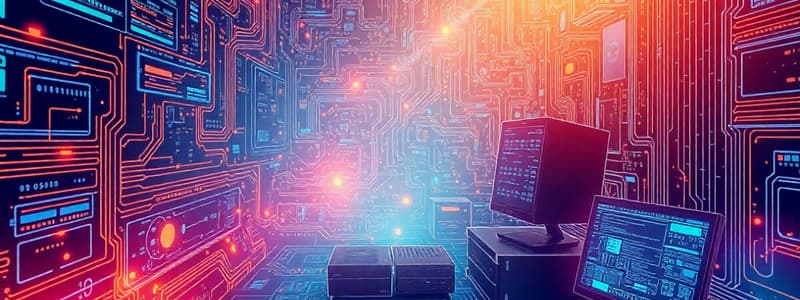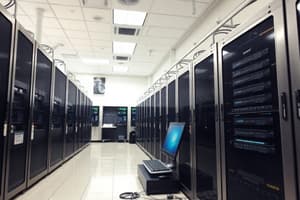Podcast
Questions and Answers
Which of the following scenarios best illustrates the use of a Wide Area Network (WAN)?
Which of the following scenarios best illustrates the use of a Wide Area Network (WAN)?
- Connecting multiple branch offices of a company located in different cities. (correct)
- Linking devices within a home network.
- Connecting computers in a single office building.
- Enabling communication between devices in a Bluetooth network.
In a relational database, what is the primary purpose of a foreign key?
In a relational database, what is the primary purpose of a foreign key?
- To ensure that all data entries in a column are unique.
- To encrypt sensitive data stored in the database.
- To uniquely identify each record within its own table.
- To establish a relationship between two tables. (correct)
During which stage of the System Development Life Cycle (SDLC) is the system architecture typically created?
During which stage of the System Development Life Cycle (SDLC) is the system architecture typically created?
- Analysis
- Implementation
- Planning
- Design (correct)
Which of the following security measures is most effective in preventing unauthorized access to a network?
Which of the following security measures is most effective in preventing unauthorized access to a network?
Which type of software is most suitable for performing complex calculations and data analysis?
Which type of software is most suitable for performing complex calculations and data analysis?
How does Artificial Intelligence (AI) primarily contribute to technological advancements?
How does Artificial Intelligence (AI) primarily contribute to technological advancements?
What is a key ethical consideration regarding the use of personal data collected through IT systems?
What is a key ethical consideration regarding the use of personal data collected through IT systems?
What role does normalization play in database design?
What role does normalization play in database design?
What is the primary goal of the 'Testing' stage in the System Development Life Cycle (SDLC)?
What is the primary goal of the 'Testing' stage in the System Development Life Cycle (SDLC)?
An employee accesses and copies confidential customer data without authorization. What type of computer misuse does this scenario exemplify?
An employee accesses and copies confidential customer data without authorization. What type of computer misuse does this scenario exemplify?
Which of the following scenarios best exemplifies the transformation of data into information?
Which of the following scenarios best exemplifies the transformation of data into information?
In the context of the data processing cycle, which of the following actions represents the 'output' stage?
In the context of the data processing cycle, which of the following actions represents the 'output' stage?
A computer program suddenly shuts down, and all unsaved data is lost. Which type of storage is most likely responsible for this loss of data?
A computer program suddenly shuts down, and all unsaved data is lost. Which type of storage is most likely responsible for this loss of data?
Which of the following actions is primarily managed by system software rather than application software?
Which of the following actions is primarily managed by system software rather than application software?
Which of the following describes source code that is easier for humans understand, making software development more accessible?
Which of the following describes source code that is easier for humans understand, making software development more accessible?
In a network, which topology connects each device to a central hub or switch?
In a network, which topology connects each device to a central hub or switch?
What is the primary function of network protocols?
What is the primary function of network protocols?
Which component of the CPU is responsible for performing mathematical calculations and logical operations?
Which component of the CPU is responsible for performing mathematical calculations and logical operations?
Which of these IT functions is primarily concerned with maintaining and repairing computer systems?
Which of these IT functions is primarily concerned with maintaining and repairing computer systems?
Which programming language is generally considered closest to machine code?
Which programming language is generally considered closest to machine code?
Flashcards
Information Technology (IT)
Information Technology (IT)
Using computers & software to handle information.
Data
Data
Unprocessed facts and figures.
Information
Information
Processed, organized, and meaningful data.
Data Processing Cycle
Data Processing Cycle
Signup and view all the flashcards
Hardware
Hardware
Signup and view all the flashcards
Input Device
Input Device
Signup and view all the flashcards
Output Device
Output Device
Signup and view all the flashcards
Central Processing Unit (CPU)
Central Processing Unit (CPU)
Signup and view all the flashcards
Software
Software
Signup and view all the flashcards
Network
Network
Signup and view all the flashcards
Local Area Network (LAN)
Local Area Network (LAN)
Signup and view all the flashcards
Wide Area Network (WAN)
Wide Area Network (WAN)
Signup and view all the flashcards
Database Management System (DBMS)
Database Management System (DBMS)
Signup and view all the flashcards
Relational Database Model
Relational Database Model
Signup and view all the flashcards
Primary Key
Primary Key
Signup and view all the flashcards
Foreign Key
Foreign Key
Signup and view all the flashcards
System Development Life Cycle (SDLC)
System Development Life Cycle (SDLC)
Signup and view all the flashcards
Testing (in SDLC)
Testing (in SDLC)
Signup and view all the flashcards
Firewall
Firewall
Signup and view all the flashcards
Encryption
Encryption
Signup and view all the flashcards
Study Notes
- Information Technology (IT) involves the use of computers and software to manage and process information
- IT encompasses a wide range of technologies, including hardware, software, networking, and telecommunications
Data and Information
- Data consists of raw and unorganized facts that need processing
- Information is data that has been processed and organized in a meaningful way
- The data processing cycle consists of input, processing, output, and storage
- Input involves gathering or capturing data
- Processing involves manipulating and converting data into information
- Output involves presenting information to the user
- Storage involves saving data and information for future use
Hardware
- Hardware refers to the physical components of a computer system
- Input devices enter data into the computer (e.g., keyboard, mouse, scanner)
- Output devices display or present information from the computer (e.g., monitor, printer, speakers)
- Processing devices include the Central Processing Unit (CPU), which performs calculations and controls the computer's operations
- The CPU contains the control unit (CU), arithmetic logic unit (ALU), and registers
- Storage devices store data and information (e.g., hard drives, solid-state drives, USB drives)
- Primary storage (RAM) is volatile and provides fast access to data
- Secondary storage (hard drive) is non-volatile and provides long-term storage
Software
- Software consists of programs and instructions that tell the computer what to do
- System software manages the hardware and provides a platform for running applications
- Operating systems (OS) manage hardware resources and provide a user interface
- Utility programs perform maintenance tasks (e.g., disk defragmentation, antivirus)
- Application software performs specific tasks for the user (e.g., word processing, spreadsheets, games)
- Programming languages are used to create software applications
- High-level languages are easier for humans to understand (e.g., Python, Java)
- Low-level languages are closer to machine code (e.g., assembly language)
Networking
- A network is a collection of computers and devices connected to share resources and information
- Network topologies describe the physical or logical arrangement of devices on a network
- Bus, star, ring, and mesh are common network topologies
- Network protocols are sets of rules that govern communication on a network
- TCP/IP is the standard protocol suite for the Internet.
- Network hardware includes routers, switches, and network interface cards (NICs)
- Local Area Networks (LANs) connect devices within a limited area
- Wide Area Networks (WANs) connect devices over a large geographical area
- The Internet is a global network of interconnected networks
- The World Wide Web (WWW) is a collection of web pages accessed via the Internet
- Cloud computing involves delivering computing services over the Internet
Database Management
- A database is an organized collection of data
- A Database Management System (DBMS) is software used to create, manage, and access databases.
- Database models include relational, hierarchical, and network models
- The relational model organizes data into tables with rows (records) and columns (fields)
- Primary keys uniquely identify each record in a table
- Foreign keys establish relationships between tables
- SQL (Structured Query Language) is used to interact with relational databases
- SQL commands include SELECT, INSERT, UPDATE, and DELETE
- Database design involves planning the structure and organization of a database
- Normalization is the process of organizing data to reduce redundancy and improve data integrity
System Development Life Cycle (SDLC)
- The SDLC is a structured process for developing information systems
- Stages of the SDLC include:
- Planning: Defining project goals and scope
- Analysis: Gathering and analyzing requirements
- Design: Creating the system architecture and specifications
- Implementation: Writing code and building the system
- Testing: Verifying that the system meets requirements
- Deployment: Installing and launching the system
- Maintenance: Providing ongoing support and updates
- Different SDLC models include waterfall, agile, and iterative models
Information Security
- Information security involves protecting data and systems from unauthorized access, use, disclosure, disruption, modification, or destruction
- Threats to information security include malware (viruses, worms, Trojans), hacking, and phishing
- Security measures include:
- Firewalls: Prevent unauthorized access to a network
- Antivirus software: Detects and removes malware
- Strong passwords: Protect user accounts
- Encryption: Encodes data to prevent unauthorized access
- Access controls: Restrict access to data and systems
- Backups: Create copies of data for recovery purposes
- Ethical considerations in IT include privacy, intellectual property, and responsible use of technology
- Computer misuse includes unauthorized access, data theft, and spreading malware
- Legislation related to IT includes data protection laws and cybercrime laws
Productivity Tools
- Word processors create and edit documents (e.g., Microsoft Word, Google Docs)
- Spreadsheets organize and analyze data (e.g., Microsoft Excel, Google Sheets)
- Presentation software creates and delivers presentations (e.g., Microsoft PowerPoint, Google Slides)
- Database software manages and organizes data (e.g. Microsoft Access)
Emerging Technologies
- Artificial intelligence (AI) involves creating computer systems that can perform tasks that typically require human intelligence
- Cloud computing involves delivering computing services over the Internet
- Mobile computing involves using mobile devices (e.g., smartphones, tablets) to access and process information
- Internet of Things (IoT) involves connecting everyday objects to the Internet
Social and Ethical Implications of IT
- IT has transformed communication, education, and business
- Digital divide refers to the gap between those who have access to technology and those who do not
- Privacy concerns arise from the collection and use of personal data
- Intellectual property rights protect the creations of individuals and organizations
- Ergonomics involves designing workplaces and equipment to reduce the risk of injury
Studying That Suits You
Use AI to generate personalized quizzes and flashcards to suit your learning preferences.



